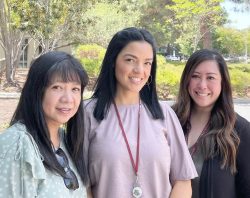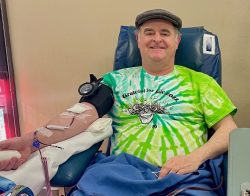
Answering the Call: Behind the Scenes of Special Donations’ Most Urgent Patient Requests
By Krista Thomas, Communications Strategist
When most people give blood, they do so without even a hint as to who or what type of patient could be on the receiving end, and they rarely have the opportunity to give to the same patient twice. Many of our blood donors have embraced this extreme anonymity, and find it enhances their connectedness to the community at a broader level.
And yet, there is a small cohort of donors who either are selected based on a specific patient need, or self-select based on a personal relationship to a patient, to give to a designated individual on one or multiple occasions. Donations such as these, though less common or well-known in the community, are a very important part of the work SBC and our donors do.

Special Donations team members (left to right): Cynthia, Lupe and Gerlie
To manage the variety of donation processes under this category of “Special Donations,” SBC has a dedicated team of three full-time team members: Lupe Alcantar, who has worked at SBC for 25 years; Gerlie Bernardino, who has worked at SBC 20 years; and Cynthia Evora, who has worked at SBC for nearly 33 years! Together, they facilitate four main types of donations that require quick thinking and many extra layers of coordination:
- directed donations, when someone asks that their donation go to a specific person (usually a family member or friend);
- autologous donations, when a person donates so they can use the blood themselves at a later date (typically in preparation for a major surgery);
- therapeutic donations, when a person donates blood because they, the donor, medically benefit (typically when the person produces too many red cells); and
- the subject of our article today, HLA-matched donations, including granulocytes…
HLA stands for human leukocyte antigen and refers to a type of molecule on the surface of many cells. HLA-matched donations are called for when a patient needs blood that is matched to theirs even beyond sharing the same ABO group (A, B, O or AB) and Rh status (+ or -). This is typically the case when patients receive donations over a long period and, as a result, are at higher risk for developing antibodies to components in transfused blood that are different than their own.
Granulocyte donations are a specific type of HLA-matched donation of white blood (immune) cells that, per Lupe, are called for “as a last resort” when a patient really needs help fighting. “Granulocyte or ‘granny’ orders are fairly uncommon — probably we get them about three times per year; but, when we do, we drop everything to work on them and identify matching donors and schedule them as soon as possible,” she said.
In terms of process, as you can imagine, finding a donor with a close enough match to a specific patient involves a specialized system in which our Special Donations experts enter all the baseline criteria, and see if blood profiles come up with any matches — and then, of those, see if they’re true candidates. “The more criteria you enter, the smaller the list,” said Lupe. “Sometimes you may get a list of 50, but only two are eligible anymore due to other factors.”
Once they have sorted through their candidates, they make contact with the potential donors as quickly as possible and explain the need in hopes that someone will be willing to come in quickly, take a medication to increase white cell production, and donate for anywhere from two to three hours to support the patient in critical need.
A Donor’s Perspective
The generosity our HLA-matched donors exhibit makes a tremendous difference in the quality of care and overall health outcomes of the patients we support. One of the best ways to showcase these special types of donations is to highlight the donors who make these donations possible.
One of our most dedicated and experienced granulocyte donors is Andy Wadsworth. Andy began donating blood in 1992 when his workplace hosted a blood drive with SBC. When asked his motivation, Andy said, “I’ve always been a person who, if I can help others, I do. I think I inherited that mentality from my father. He was the type who would stop on the freeway to help any car that was pulled over — it would take forever any time we took a family trip because we’d have to stop three or four times each way!”
 The first time Andy donated, he learned he was type O+, which is the most common and, consequently, most commonly needed blood type. And, because he is CMV negative, his blood is well-suited to support children, especially preemie babies. “I love kids and do as much as I can for kids,” Andy said. “So, when they gave me a ‘preemie donor’ sticker, I slapped it on my chest immediately and began looking for opportunities to donate more often.”
The first time Andy donated, he learned he was type O+, which is the most common and, consequently, most commonly needed blood type. And, because he is CMV negative, his blood is well-suited to support children, especially preemie babies. “I love kids and do as much as I can for kids,” Andy said. “So, when they gave me a ‘preemie donor’ sticker, I slapped it on my chest immediately and began looking for opportunities to donate more often.”
Andy’s love for supporting his community motivated his increasing involvement. He went from donating for the first time, to making special trips to the donor centers outside of his workplace drives and, eventually, to donating platelets, which allowed him to give far more frequently. “I remember talking to my mom about donating platelets and she commented that I was ‘shining my halo,’” he said.
In late 2000, Andy’s regular donations were interrupted by a false positive on an infectious disease screening test. Since no reentry mechanism (i.e., approved pathway to be allowed to donate again) existed back then, SBC suggested he hold off from blood donations until the screening test was able to be updated, since another positive could mean permanent deferral. It wasn’t until seven years later Stanford confirmed he tested fine on the new test and was able to return as a community blood donor. Though it would have been understandable if the long time away had dulled his passion, Andy felt only excitement at the opportunity to get back to helping local patients. Andy restarted his whole blood donations and eventually worked back up to monthly platelet donations, this time on a new single-arm platelet collection system (before, the process had required a needle in both arms) and with brand new DVDs to watch during his appointments!
Andy was first contacted about HLA-matched donations — specifically granulocytes — in 2017. “I remember the folks at SBC telling me it was for an immediate need, someone in bad shape, and that that person was going to need donors every day until they either recovered or didn’t make it… I said, ‘Absolutely,’ and told them to call as often as they needed.”
“Every time Andy comes up as a match with a specific patient, we know that we can depend on him to always be there willing to help save a life. He is truly a lifesaver,” said Cynthia, Research & Clinical Services Specialist.
Aside from the knowledge that his donation is going to a specific patient, there are a few differences he noted in the granulocyte process. Procedurally, it involved taking a medication in advance as well as a return to the two-arm donation process, and it tends to take longer than a platelet donation. Perhaps most notably, the weight of the donation — knowing that it is a specific patient in a very critical state — can put things in a different perspective.
“The first time I was supposed to donate granulocytes, I knew it was for a person in extreme need, but my appointment was cancelled. I remember thinking that there were only two reasons a patient no longer needed my donation… they either got better, or they didn’t. Thinking about those two possible outcomes really brought home how critical these donations are,” he said.
Of the eight times Andy has been scheduled to donate granulocytes over the past six years, about 50% of his appointments have been cancelled. For Andy, the weight of knowing these unnamed patients may not have made it makes donating granulocytes especially emotional.
“It’s very much more personal. You don’t get the patient’s name, but you know this donation is going to a specific person, and you even know the day they’re going to get it. It almost feels like you’re there with them,” he said. “If I’m told the donation is no longer needed, I’m now at peace with the fact that I can say a prayer and concentrate my energy on hoping that the reason they no longer needed it was because they healed, which is also a possibility, and one I hope would be the case for all these patients.”
While answering the call for special donations, Andy continues to donate platelets regularly. He has now been donating for roughly 25 years and has accumulated 171 lifetime donations, a journey he has enjoyed sharing with his loved ones — even setting a special countdown clock on Facebook for his 100th donation! Though his community has been incredibly supportive, they’ve also made him realize just how many people aren’t able to donate, which makes it all that more important for those who can donate to do so — be it whole blood, special donations, or anything in between.
“Just think, how often do you get to save a life, not because of circumstances, like you were in the right place at the right time; not because you had the right medical training or education, or financial resources; but because you made a decision to set aside time and give someone in need an opportunity at life? Blood donation is an incredible thing because it shows us that many of us, regardless of our background or our training, have the ability to save lives,” Andy said. “If you are able to do it, I can’t recommend it enough. As my mother said, there’s no better way to ‘polish your halo.’”
